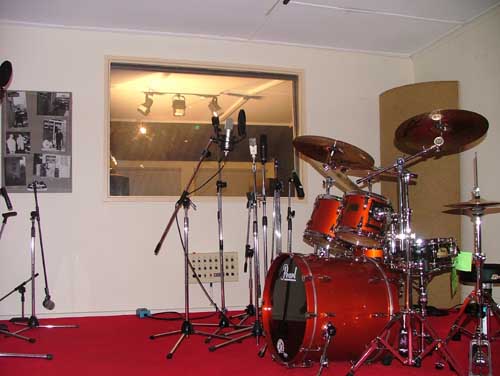

| HOME | ARTICLES | REVIEW | RESOURCES | DIRECTORY | SITE MAP |
Keyboard Magazine "In The Studio" Using Noise gates With Keyboards - Part II
One popular professional manufacturer that was one of the first to market a noise gate was Valley People's "Kepex". The name Kepex was short for the keyable programable expander. A noise gate is an expander. The ratio control found on most gates, defines expansion from noise gating. The lower ratios (i.e. 1 to 2 and 1 to 4) are in the range of expansion and the higher ratios (1 to 10 and above ) are considered gating. Now the "Key Input" allows the gate to follow the dynamics and envelope of the program material that is feed into it. The way that this is most commonly used in the studio is for tightening up tracks. For example : one a multi-track tape there are three tracks of Horns all doubling the same lines. All three tracks do not end sustaining their phrases at the same times. We've chosen the first track of Horns to be the trigger track because the amount of sustain was correct. We then feed the audio of the other two horn tracks each into a separate noise gate. We set each of these gates to external Key mode (meaning each gate is waiting for a trigger from the key input). We then mult the audio of track one into the "key Input" of both gates while also allowing it to return to the console as well. We set the release of the two gates to follow the first track. When the audio of the first track stops, the gates close and thus tighten the envelopes of all three tracks together. The above example can very easily be used when recording multiple midi tracks doubling up the same line. The procedure above must be used when recording multi midi instruments (i.e. using an entire Yamaha TX-816 rack for a brass sound) to the same track. If you record each module of the TX-816 to a separate track, then it can be fixed in the mix. It is in the mix that unfortunately most of the sloppy envelopes are discovered. Another useful function of the Key Input is to add excitement to percussion instruments. For instance, the trigger track (or instrument) in this case will be a snare drum. It sounds sort of dead and not exciting enough so we are going to add some white noise to it and lengthen it's original envelope. We do this by getting up some white noise on a synth (Minimoog or Arp 2600 - What you don't own one anymore?) and feed it into a noise gate. Set the gate to Key input mode. Make sure your synth is sending out a steady white noise ( ya know, the pencil wedging down the key trick) and patch the snare track into the Key input. When ever the snare sounds, the gate will open and white noise will be added to the snare sound. Set the release as desired to have the white noise trail off longer than the original snare's envelope. Also fooling with a slower attack time with get the crack of the snare and then the white noise trailing off. A little reverb and it's deadly. A similar setup can be used to add a tonality to a tom tom. Instead of white noise use a particular pitch or even a chord. Again you can set the envelope as you wish. The vocoder does this in a more elaborate way. But don't expect to follow the sybilance and resonance's of a vocal track with this above technique. Leave that for a good quality vocoder. Other interesting effects can be gotten by using a gate's key input to simulate arpeggiation. Use a high hat track to key your bass line or chord lines in a song. You will most likely have to double up and use two or more gates to really tighten the keyed envelop but that is understandable. Background vocals can follow the envelope of your rhodes part in a ballad. The boundaries are endless, so use you imagination to the fullest. There are no rules in the keyable programmable expander zone. Sampling? Well if your not using noise before the audio input of your sampler, your missing the trick ! When sampling percussive sounds with envelopes that will decay natrually it is important to gate the envelope of that sound so that you're not sampling hiss. Trying to truncate the end of the sampled sound will only make the hiss more apparent. Set the gate's release to follow the original sound's envelope so that before sampling a sound, the hiss will almost be nonexsistant. Now, if you're planning to loop a sample, gating is not as critical but I recommend having a gate normalled and ready. I hope this primer will help you all on your way. The only way. The way of the "Hiss Patrol". Hi Oh Silver ! Away ! |
Copyright 2026 Yankeenineniner.com All rights reserved.
|
 Last month we discussed the basics of using noise gates for simple things, like eliminating noise. But this month I'm gonna show you some more interesting applications of the noise gate.
Last month we discussed the basics of using noise gates for simple things, like eliminating noise. But this month I'm gonna show you some more interesting applications of the noise gate.